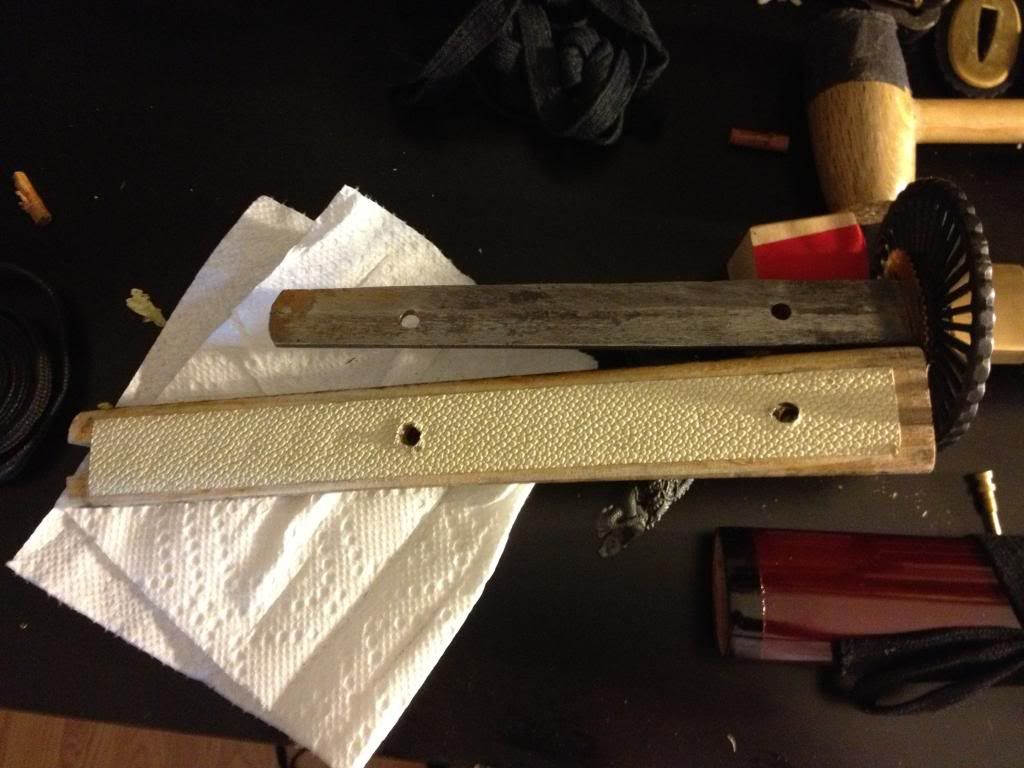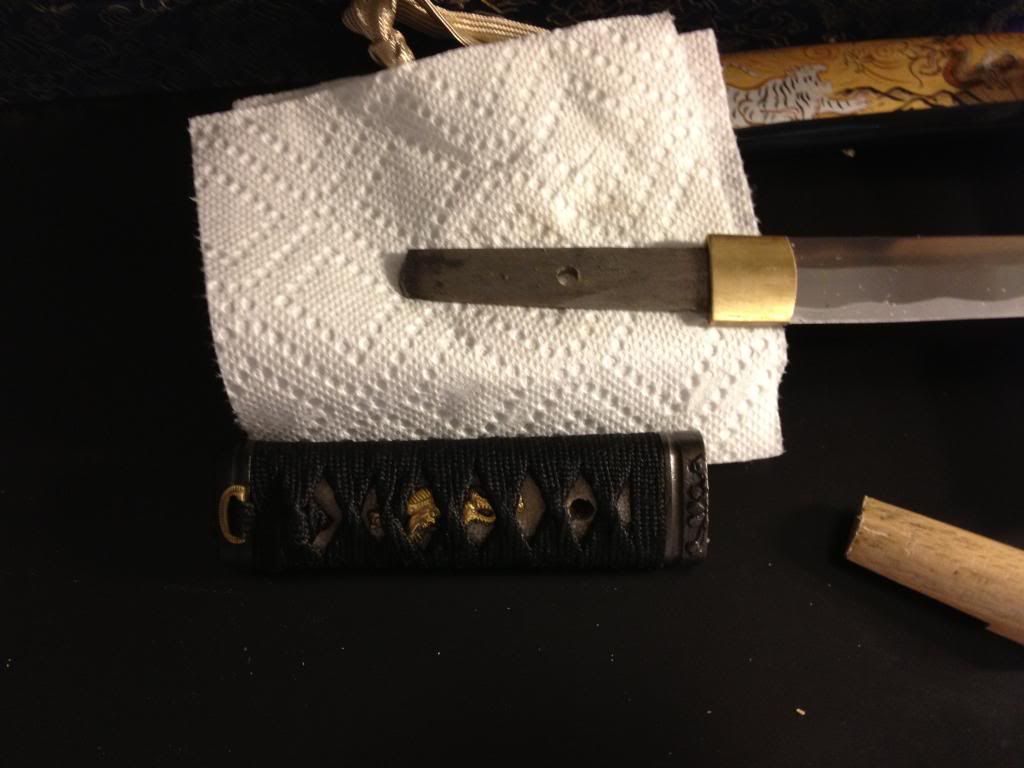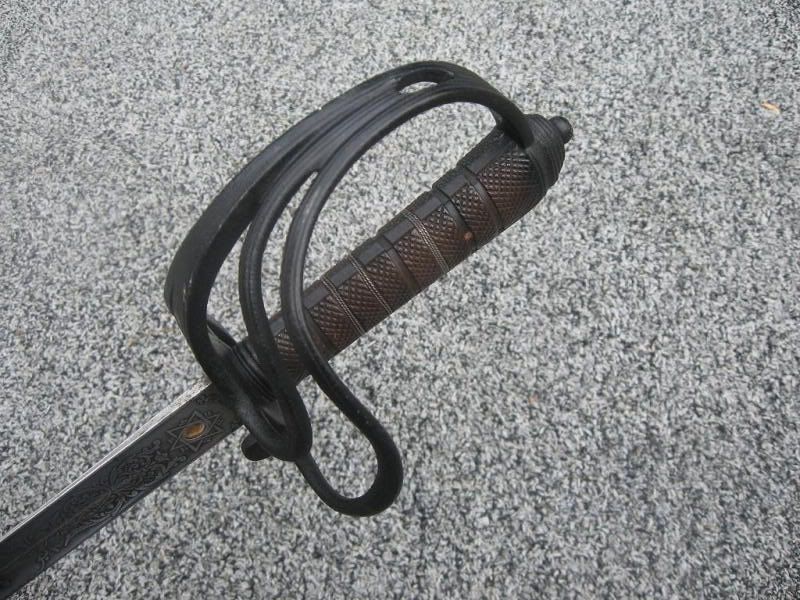|
|
Post by THE_SUPERWEIRDO on Jun 3, 2013 3:50:06 GMT
After disassembling and inspecting a sword set I bought, I encountered this:  My initial reaction was freaking out, thinking that this is not an actual full tang to be usable. Then, I thought it wouldn't be big of a problem, since it is "full" with the width of it, just not the length. Also, the sword is sub-$100, so it is expected... So in short, I'm currently torn by my differing thoughts. :? Or am I just freaking out over a small thing? :oops: I mean, it is just an inch or two of missing tang... Right? :? So when is it okay for a tang to be usable and when will it be too weak to be usable? And if the tang is short for it's handle, is it still considered okay to use it? Also, I encountered a similar problem with a tanto I bought along the swords:  But it's in a smaller scale so I guess it's okay? .... This is a first for me, having to worry about tangs. And for those who are wondering, the set is the Musashi Last Samurai Katana Set that I bought from SwordNArmory. The tanto is the "Black Tanto Handmade Carbon Steel Samurai Sword with Dragon and Tiger Scabbard" also from SwordNArmory. Some cheap and reliable swords was something I was looking for that can be used for some light cutting in a somewhat daily basis... Then the tang thing just came up. :? |
|
|
|
Post by randomnobody on Jun 3, 2013 4:02:06 GMT
Classically, a "full tang" is one that is merely sandwiched between slabs, visible from the edges, and usually integral to the pommel (if there is one), but in recent years it has come to mean any tang that is considered a suitable size for safe use. Historic swords had very skinny tangs, some very short. Many of these were only glued into a block of wood and called done. Provided every other aspect of construction is adequate, this is all that is necessary. In Japanese swords, specifically, there was a period (and a style) that saw tangs only a few inches long, usually half or less the length of the hilt. These swords were used, and consensus shows they did fine. Yours are certainly more than substantial enough for their function. What we need to worry about is what we refer to commonly as the "rat tail" tang, which is another misnomer as what many knives have had throughout history (and continue to have today) is what we would call a "rat tail" tang. A "rat tail" is a skinny bit of a stick, usually round or very slightly flattened at the sides, that is adhered into a surrounding grip either by common adhesives (epoxy, resin, etc.) or pure friction and hope. These knives have served flawlessly for ages now. What we need to worry about are welded-on "rat tail" tangs. Take apart the common wall hanger, see the maybe half-inch rectangular protrusion from the bottom-center of the blade with a bit cut out to allow for the rod you see welded in place. That is the breaking point, more often than not. Many traditionally made and contemporary kukris use the classical "rat tail" tang in their construction, but it is an integral piece. That is, it is hammered out from the same billet of steel as the blade, leaving one contiguous piece of steel. Ideally the shoulders at the blade/tang junction are rounded to distribute shock, versus the very square corners of modern wallhangers. Folks are hard on their kuks, and they take it in stride. That said, go look at your favorite pocket knife. How's the tang on that thing? Still use it?  What one might consider for modern katana is whether the tsuka core has been completely cut out the whole way, or only where the tang actually rests, as the gap at the end could be a source of weakness since it is more flexible than a solid chunk of wood (albeit two slabs glued together) would be. Also one must check the mekugi pegs often, as all too often these are the only things keeping the blade inside the handle to begin with. This is why many modern swords use two, where classically only one was deemed necessary. If the pegs come out, as the cheaper, straight cylindrical ones have a habit of doing, versus the preferred conical form, the blade could well be released on the next swing. In olden days, the peg was to be inserted from the side the top hand would be gripping, and in early days I think they were covered by the menuki "ornaments" we're familiar with as standing in bizarre places now. This was just an extra step to prevent them coming all the way out; should it start to slip, the palm would press it back in again, and hold it in place. Alternatively, there are the riveted slabs seen in "messer" type blades on the European side. Nobody's questioning the tangs on those. Conversely, a LOT of the swords from Southeast Asia (Philippines etc.) have glued-in "rat tails," but have a fantastic record of safety and success in their deployment. |
|
|
|
Post by Wichita Ronin on Jun 3, 2013 4:06:11 GMT
Looks fine to me for light and medium size targets aslong as the tsuka is not cracked but im no expert.
|
|
|
|
Post by Timo Nieminen on Jun 3, 2013 9:43:49 GMT
It isn't a full tang. This is a 3/4 tang. Strictly speaking, no katana is really full tang, but it's fair to call the ones where the tang almost reaches the end of the tsuka "full tang". 2/3 to 3/4 tang are common on antique katana. "Full tang" doesn't make a sword safe - proper construction makes a sword safe. Lack of a full tang doesn't make a sword unsafe - an appropriate tang and properly made handle make a sword safe. If you would prefer it to be full-tang, you can always shorten the tsuka  Well, that's not necessarily a silly idea. A too-long hilt can get in the way. Edo period official regulation tsuka were supposed to be 8 sun, which is a little under 10". |
|
|
|
Post by THE_SUPERWEIRDO on Jun 3, 2013 21:21:38 GMT
Sweet, I'm relieved and learning something new. Thanks for the responses! I can continue my little project with these swords with peace in mind. Really did not know most swords aren't actual "Full" tang. It sounds like some marketing hype to me now...  |
|
|
|
Post by Timo Nieminen on Jun 3, 2013 22:00:05 GMT
Katana were not full tang, but could be close enough. Some tachi were full tang. Non full tang katana were common, even standard.
Chinese swords were almost always full tang.
Western swords were usually full tang. Some Western swords were built like large knives, and could be other than full tang.
South East Asian swords are not usually full tang.
Indian swords are not usually full tang.
Turkish/Persian/Central Asian swords can be full tang or partial tang, both are used often.
African swords can be either.
So, you are probably right to say that most swords were not full tang. Probably most military swords were full tang; the Chinese and (modernish) Western swords should provide a majority.
|
|
|
|
Post by randomnobody on Jun 3, 2013 22:16:19 GMT
Yeah, "full tang" doesn't really mean anything, but is big marketing. It came about after people started learning that you need more than a rod welded on to make it a proper sword.
Timo: I wonder, the "Western swords" you're referring to, are you addressing the types wherein the "tang" protrudes beyond the pommel and is either hammered over the end or fixed with a threaded nut, regardless of whether the tang is exposed from the sides, slab style? I know many swords are wrapped all-round with leather, so deciding whether the wood underneath is a "whole" grip or just slabs, but I wonder if this may impact the "full" idea in some "Western Swords" or not?
Just for clarification sake.
Oh, also, with regard to military swords, is that referring to the modern variants or the patterns throughout later periods into the modern day? Does this refer to slab types or simply peened? I've seen a number of both (but have no ready examples to show), and wonder if it makes a difference?
|
|
|
|
Post by Timo Nieminen on Jun 4, 2013 0:58:50 GMT
For swords, "full tang" usually means "full length tang", and doesn't require a "full width tang". Full-width tangs are done, on slab-grip swords (in traditional European practice, these were knives ("messer"), not swords, however long the blade was, but we can call them swords). Which would include the Medieval European messer, Chinese slab-gripped militia jian, some dao/dadao, some Middle Eastern and Central Asian swords.
By military swords, I mean swords that were made for military use, to be carried by soldiers as battle weapons. As opposed to, say, a sword somebody might carry every day, and then take along to war when they are summoned for feudal service.
The majority of Chinese ones did not have slab grips, so didn't have full-width tangs. Plenty of 19th century European military swords had full-width tangs and slab grips. Can't think of many 18th century or earlier.
Does it make a difference? Either will be good if properly made. Full-width slab grips might be easier to make well enough in large numbers, or with less skill. The enclosed tang (i.e., non-full width) does have advantages - can be lighter, less hand shock, easier to change pommel and guard.
|
|
|
|
Post by randomnobody on Jun 4, 2013 1:42:56 GMT
Thanks, just curious which definitions we were using. Seems everybody has a slightly different idea of what "full" means when it comes to tang.
I remember when "full tang" stuff first took off, in the katana world. it was the slab type construction and THE GREATEST THING EVAR. Then we realized they weren't very comfortable and didn't look good, and suddenly we remembered how they were actually supposed to be made and here we are today.
Interesting note on Messers, too. Not one I was personally unfamiliar with, but a good point for those who aren't. I've found a lot of cultures have made "sword-length knives" over the years, presumably stemming from old edicts forbidding "swords" and the convenient differentiations given at the time. Seems a lot of them had the "full-width" slabbed tangs.
Just wanted to be sure, because there are still people out there who will say a sword is not properly "full tang" if said tang is not visible, but I think many would agree as long as a tang is of proper dimensions relative to the width of the blade and length of the hilt and not welded on...it'll do the job just fine.
|
|
|
|
Post by Kilted Cossack on Jun 5, 2013 15:20:16 GMT
 Image borrowed from myarmoury.com, post by Nathan Robinson. A Wilkinson P1821 Royal Artillery Officer's Sword with Patent Solid Hilt construction. |
|

